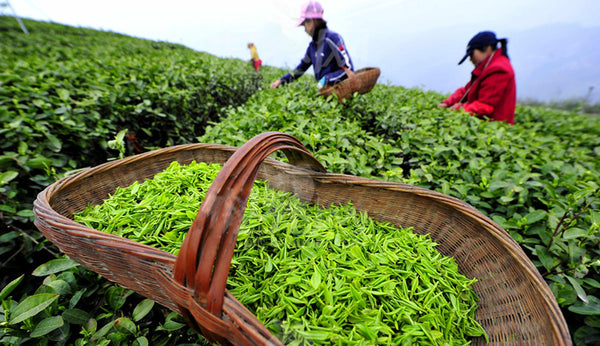The tea plant and harvesting

Many people don't realise that most teas are made from the same plant - the Camellia Sinensis. When I say most teas we're talking about Black, Green, White, Oolong and some Chai teas. These teas look and taste very different so how can they be made from the same plant?
Well it's actually very simple and it's all down to how long the tea is oxidised but we'll explain more on this in a minute. Other teas, like Rooibos, Mate, Fruit and Herbal are blends and don't usually have what we would call a tea leaf in them.
The Camellia Sinensis is a species of ever green shrub and can grow into a small tree, however most estates prune them to waist height for easy plucking. Its leaves are used to produce tea whilst the seeds are pressed to produce tea oil. It's native to East Asia but today you can find it being cultivated all over the globe even as far north of the equator as Cornwall! It tends to thrive in tropical regions with over 50 inches of rainfall each year; which explains why it's doing well in the UK I guess.
So how is tea harvested or made? Well not all teas are made equally but if it's a Camellia Sinensis based tea then it will likely follow this process.
Handpicked
It all starts at the harvest where the best tasting tea leaves from the Camellia Sinensis plant are hand plucked. The delicate unopened buds and leaves are carefully selected to ensure the most flavor when it reaches your cup. We pride ourselves on selecting only the finest teas and avoid the lower quality tea which uses a much broader leaf and is machine harvested.
Withering
The tea leaves are then left to wither in fresh air until they have lost about 50-65% of their weight in moisture. This is caused by the enzymes in the tea leaves reacting with the oxygen and helps to prepare the tea for the next stage.
Oxidisation
The loose tea leaves are then placed in a temperature controlled room with high humidity so they can oxidise. The longer the oxidation the darker the tea. So black tea is 100% oxidised whereas white teas are not. That's why teas from the same plant taste and look differently.
Rolled
Once the tea has reached the desired level of oxidation the process then needs to be stopped so heat is applied to the leaves to deactivate the enzymes. The tea leaves are then rolled which creates the curled up shape and helps with transportation. Most teas that you find in tea bags are made using fannings which is dust left behind from the process of rolling whole tea leaves.
Drying
The loose teas leaves are then dried which marks the final stage in the process. This can be done in an oven, naturally or better quality teas are dried in sunlight which leads to a much fuller flavour.
So as you can see the process from harvest to cup is lengthy and at each stage the flavour can be compromised. The most important stage is the harvest and ensuring the best quality leaves are chosen. Unfortunately most teas available these days use very poor quality tea called fannings that is packed full of artificial flavours to boost the taste. Such a shame as most of the goodness of the Camellia Sinensis is found in the oils of the whole leaf and usually this never reaches your tea cup with so many of us still drinking tea in bags.



